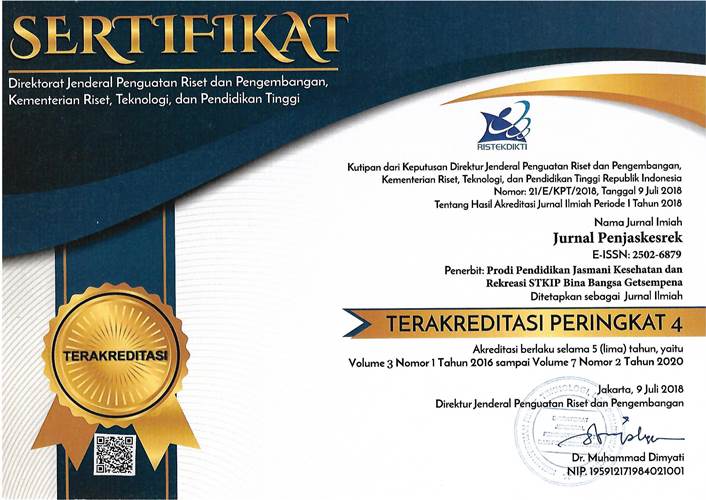ANALISIS DAMPAK WABAH COVID-19 PADA PERKEMBANGAN MOTORIK HALUS ANAK USIA 3-4 TAHUN
Abstract
This study aims to determine the impact of the COVID-19 outbreak on fine motor development of children aged 3-4 years. Population and sample in the study were parents who had children aged 3-4 years, the total population and samples were 28 parents. With the details of parents who have children aged 3-4 years .. fine motor skills are movements that involve finer movements performed by small muscles. These subtle movements require careful coordination. The better the fine motor movements so that the children can be creative, such as cutting paper with straight cutouts, drawing simple pictures and coloring, using clips to join two sheets of paper together, sewing, weaving paper and sharpening a pencil with a pencil sharpener. The instrument used for data collection was in the form of a questionnaire presented in the form of a google form which was distributed through social media, with the data obtained as an indicator of fine motor skills that children aged 3-4 years old can do. The research results that have been found are presented in descriptive quantitative form. To obtain the final results of data collection, the data need to be converted into a percentage. The result of this percentage is used as the basis for collecting data on the impact of COVID-19 on the fine motor skills of children in the family environment. Determining the results can be seen from the assumptions of parents with fine motor skills that can be done by children aged 3-4 years. The results of this study have positive results which can be seen from the 10 questions given from 28 parents or families who answered that the average result of each indicator was 96.4% as many as 8 questions, and only 2 questions had indicators at 92.9%. By calculating the percentage of things that children can do regarding fine motor movement, then divided by 10 indicators according to what is presented in the table, as a whole regarding the analysis of the impact of the Covid-19 outbreak on fine motor development of children aged 3-4 years has a percentage of 80% including in positive development criteria.
References
Alim, S., & Arizal, A. (2018). Smart Malnutrition Detection: Deteksi Dini Kecukupan Gizi Dan Rekomendasi Gizi Harian. Jurnal Informatika: Jurnal Pengembangan IT, 3(3), 324–328. https://doi.org/10.30591/jpit.v3i3.929
Astuti, D. I. Y. (2016). Asuhan Keperawatan pada Ibu S yang Mengalami Tumor Otak (Astrocytoma)di Ruang Angsoka Rumah Sakit Umum Daerah Abdul Wahab Sjahranie Samarinda. Journal of Chemical Information and Modeling, 53(9), 1689–1699.
Destiyani, J., & DH, D. P. (2019). Analisis Perkembangan Motorik Anak Pada Usia 3-4 Tahun. Seminar Nasional PAUD 2019, 48–53.
Goodway, ozmun & G. (2019). Understanding Motor Development. Journal of Chemical Information and Modeling, 53(9), 1689–1699.
Harahap, F. (2019). Kemampuan Motorik Halus Anak melalui Kegiatan Melipat Kertas Origami ( Improving Children Fine Motor Ability through Origami Folding Activity ). 2(2), 57–62.
Hendy, A. M. (2020). Relasi antara kecemasan, gender, dan hasil belajar senam lantai. Journal of Physical Education, 7(1), 15294.
Indraswari, L. (2012). Peningkatan Perkembangan Motorik Halus Anak Usia Dini Melalaui Kegiatan Mozaik Di Taman Kanak-Kanak Pembina Agam. Jurnal Pesona PAUD, 1(1–13), 1–13.
Mahfud, I., & Yuliandra, R. (2020). Pengembangan Model Gerak Dasar Keterampilan Motorik Untuk Kelompok Usia 6-8 Tahun. SPORT-Mu: Jurnal Pendidikan Olahraga, 1(01), 54–66. https://doi.org/10.32528/sport-mu.v1i01.3055
RM Agus. (2019). Pengaruh Metode Pembelajaran dan Kriteria Layanan Bantuan: Meningkatkan Gerak Dasar Lompat Jauh Gaya Jongkok Siswa Tunagrahita Ringan Pada Pembelajaran Penjasorkes SLB PKK. Halaman Olahraga Nusantara, 11(1), 1–14. http://scioteca.caf.com/bitstream/handle/123456789/1091/RED2017-Eng-8ene.pdf?sequence=12&isAllowed=y%0Ahttp://dx.doi.org/10.1016/j.regsciurbeco.2008.06.005%0Ahttps://www.researchgate.net/publication/305320484_SISTEM_PEMBETUNGAN_TERPUSAT_STRATEGI_MELESTARIKAN_
Siahaan, M. (2020). Dampak Pandemi Covid-19 Terhadap Dunia Pendidikan. Jurnal Kajian Ilmiah, 1(1), 73–80. https://doi.org/10.31599/jki.v1i1.265
Susanto, A. (2011). Perkembangan Anak Usia Dina (Vol. 4).
Wayanti, kharisma kusumaningtyas dan sri. (2016). Faktor Pendapatan Dan Pendidikan Keluarga Terhadap Perkembangan Motorik Halus Anak Usia 3-4 Tahun. Jurnal Involusi Kebidanan, VII(2011), 46–51.
Widyawati, N. (2015). Eksplorasi Olahan Makanan Berbasis Biji Gandum Domestik (Triticum aestivum L.Varietas Dewata) melalui Uji Organoleptik. Jurnal Aplikasi Teknologi Pangan, 04(02), 66–73. https://doi.org/10.17728/jatp.2015.13




















